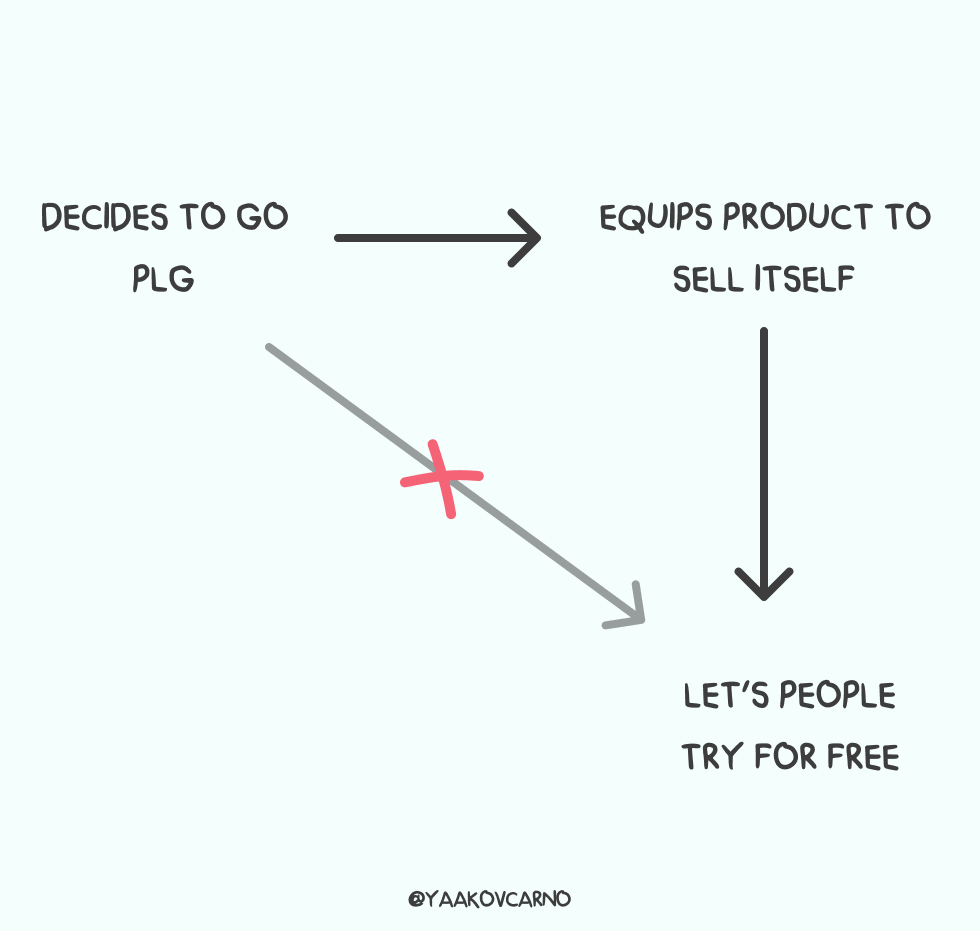Some SaaS companies let people try their product for free, hoping they will want to start paying for it.
The problem is they forget to make sure their product can do everything a salesperson would normally do.
The solution is to think about all the things a salesperson does, and then make sure your product can do these things too.
Here are 13 examples:
Articulating the product’s value proposition
Sales teams traditionally spend significant time crafting pitches to express the product's value.
Product-Led: The product experience itself needs to prove its value through user interaction. It’s about showing, not telling.
Qualifying Leads
Sales teams act like seasoned analysts, assessing leads based on demographic or firmographic data.
Product-Led: Enter Product Qualified Lead (PQL) scoring models, which qualify leads based on product usage - a more nuanced approach that delivers accurate predictions about conversion likelihood.
Conducting Proof of Concept (POC)
Traditionally, sales teams conduct tailor-made POCs to prove the product's potential.
Product-Led: Freemium or Free Trial modes serve as dynamic showrooms where users can experience the product's value firsthand, eliminating the need for a prolonged POC process.
Onboarding Clients
Typically, sales teams guide new clients through the onboarding process.
Product-Led: Consider an approach where the product itself is the guide, providing intuitive empty states, product tours, checklists, and more, allowing users to experience your product's value without human handholding.
Educating Customers
The sales-led approach often involves comprehensive demos or training sessions, akin to traditional classroom education.
Product-Led: Why not build an embedded learning system? With a comprehensive knowledge base, tooltips, or interactive guides, users have access to necessary information in a more engaging and immediate manner.
Personalizing Experiences
Sales teams, armed with their knowledge of the customer, personalize interactions.
Product-Led: Picture a product that harnesses user data to personalize the product experience, showcasing relevant features based on usage patterns - a truly user-centric approach.
Driving Conversions
Sales teams often follow up with prospects persistently to encourage conversion.
Product-Led: Automated in and out of app engagement sequences work like gentle nudges, driving conversions by sending targeted messages based on user behavior.
Negotiating Custom Packages
Sales teams often engage in negotiations to tailor custom packages for clients.
Product-Led: Instead, let's democratize customization. The product allows user-driven customization, ready-made templates, and customizable self-serve subscription models, giving users the flexibility to choose what suits them best.
Generating Leads
Traditionally, sales teams generate leads through outbound efforts, casting wide nets.
Product-Led: Product growth loops generate more usage, creating a virtuous cycle of word-of-mouth referrals, user-generated content, and collaboration.
Customer Retention and Subscription Renewals
Sales teams often manually track subscription renewals and engage in outreach to prevent churn.
Product-Led: The product uses automated triggers and personalized in-product messages to enhance retention, subtly nudging users towards features they haven't used yet.
Upselling and Cross-Selling
Sales teams identify opportunities to upsell or cross-sell to existing customers.
Product-Led: The product includes in-app prompts for feature discovery and premium upgrades, intuitively suggesting additional features based on the user's usage patterns.
Collecting User Feedback
Sales teams gather feedback through direct communication or surveys.
Product-Led: The product incorporates automated in-app surveys or feedback collection mechanisms, ensuring real-time and relevant insights are captured at the point of user interaction.
Predicting Customer Behavior
Sales teams often predict customer behavior based on past interactions and intuition.
Product-Led: The product leverages data and machine learning to anticipate customer actions, suggesting features a user is likely to need based on their behavior.
To sum up.
If you want your product to sell itself.
Make sure it has what it needs to do the job that people who sell usually do.
See you next week :)





